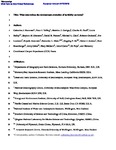What determines the downstream evolution of turbidity currents
| dc.contributor.author | Heerema, C | |
| dc.contributor.author | Talling, P | |
| dc.contributor.author | Cartigny, M | |
| dc.contributor.author | Paull, C | |
| dc.contributor.author | Bailey, L | |
| dc.contributor.author | Simmons, S | |
| dc.contributor.author | Parson, D | |
| dc.contributor.author | Clare, M | |
| dc.contributor.author | Gwiazda, R | |
| dc.contributor.author | Lundsten, E | |
| dc.contributor.author | Anderson, K | |
| dc.contributor.author | Maier, K | |
| dc.contributor.author | Xu, J | |
| dc.contributor.author | Sumner, E | |
| dc.contributor.author | Rosenberger, K | |
| dc.contributor.author | Gales, Jenny | |
| dc.contributor.author | McGann, M | |
| dc.contributor.author | Carter, L | |
| dc.contributor.author | Pope, E | |
| dc.date.accessioned | 2019-12-11T13:29:15Z | |
| dc.date.issued | 2020-02-15 | |
| dc.identifier.issn | 0012-821X | |
| dc.identifier.issn | 1385-013X | |
| dc.identifier.other | 116023 | |
| dc.identifier.uri | http://hdl.handle.net/10026.1/15245 | |
| dc.description.abstract |
Seabed sediment flows called turbidity currents form some of the largest sediment accumulations, deepest canyons and longest channel systems on Earth. Only rivers transport comparable sediment volumes over such large areas; but there are far fewer measurements from turbidity currents, ensuring they are much more poorly understood. Turbidity currents differ fundamentally from rivers, as turbidity currents are driven by the sediment that they suspend. Fast turbidity currents can pick up sediment, and self-accelerate (ignite); whilst slow flows deposit sediment and dissipate. Self-acceleration cannot continue indefinitely, and flows might reach a near-uniform state (autosuspension). Here we show how turbidity currents evolve using the first detailed measurements from multiple locations along their pathway, which come from Monterey Canyon offshore California. All flows initially ignite. Typically, initially-faster flows then achieve near-uniform velocities (autosuspension), whilst slower flows dissipate. Fractional increases in initial velocity favour much longer runout, and a new model explains this bifurcating behaviour. However, the only flow during less-stormy summer months is anomalous as it self-accelerated, which is perhaps due to erosion of surficial-mud layer mid-canyon. Turbidity current evolution is therefore highly sensitive to both initial velocities and seabed character. | |
| dc.format.extent | 116023-116023 | |
| dc.language | en | |
| dc.language.iso | en | |
| dc.publisher | Elsevier | |
| dc.subject | turbidity current | |
| dc.subject | submarine canyon | |
| dc.subject | ignition | |
| dc.subject | dissipation | |
| dc.subject | autosuspension | |
| dc.subject | flow behaviour | |
| dc.title | What determines the downstream evolution of turbidity currents | |
| dc.type | journal-article | |
| dc.type | Journal Article | |
| plymouth.author-url | https://www.webofscience.com/api/gateway?GWVersion=2&SrcApp=PARTNER_APP&SrcAuth=LinksAMR&KeyUT=WOS:000513291400007&DestLinkType=FullRecord&DestApp=ALL_WOS&UsrCustomerID=11bb513d99f797142bcfeffcc58ea008 | |
| plymouth.volume | 532 | |
| plymouth.publication-status | Published | |
| plymouth.journal | Earth and Planetary Science Letters | |
| dc.identifier.doi | 10.1016/j.epsl.2019.116023 | |
| plymouth.organisational-group | /Plymouth | |
| plymouth.organisational-group | /Plymouth/Faculty of Science and Engineering | |
| plymouth.organisational-group | /Plymouth/Faculty of Science and Engineering/School of Biological and Marine Sciences | |
| plymouth.organisational-group | /Plymouth/REF 2021 Researchers by UoA | |
| plymouth.organisational-group | /Plymouth/REF 2021 Researchers by UoA/UoA07 Earth Systems and Environmental Sciences | |
| plymouth.organisational-group | /Plymouth/Users by role | |
| plymouth.organisational-group | /Plymouth/Users by role/Academics | |
| dcterms.dateAccepted | 2019-12-07 | |
| dc.rights.embargodate | 2020-12-18 | |
| dc.identifier.eissn | 1385-013X | |
| dc.rights.embargoperiod | Not known | |
| rioxxterms.version | Accepted Manuscript | |
| rioxxterms.versionofrecord | 10.1016/j.epsl.2019.116023 | |
| rioxxterms.licenseref.uri | http://www.rioxx.net/licenses/all-rights-reserved | |
| rioxxterms.licenseref.startdate | 2020-02-15 | |
| rioxxterms.type | Journal Article/Review |


